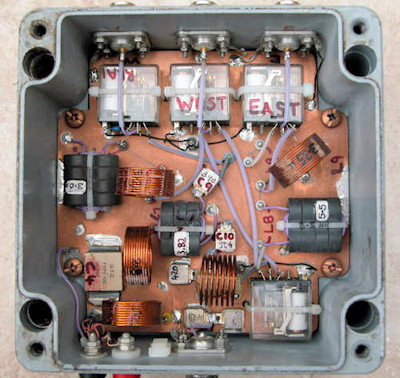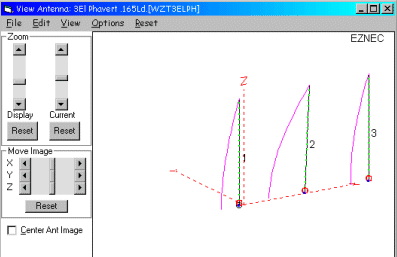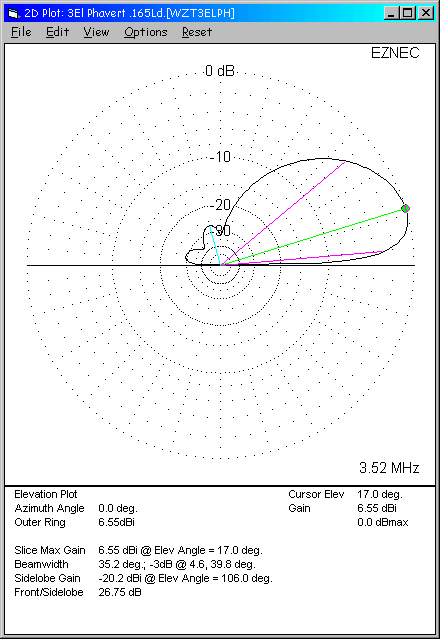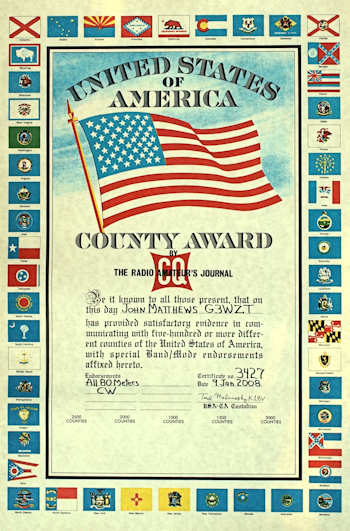![]()
![]()
Photograph showing the phasing unit Layout of the 3 verticals EZNEC Plot of my 3 Element phased array with +/- 128 deg. feed



I have written some Mathcad7™ files which do the complex number calculations and determine the driving point impedance's for a 3 element array. All that is needed as input, is the measurements of individual element self impedance and the effect of mutual impedance for each element due to coupling between elements in the array. Also required is the individual antenna current magnitude and phase. You will of course require, or have access to Mathcad7™ from MathSoft Inc. For most 3 Element arrays this will be a 1-2-1 (binomial) current distribution. There are 2 files in a "zip" for this, both are fundamental the same but with the phase of the outside elements reversed. One calculates beaming East, the other West. In a perfectly symmetrical array, where all elements have the same self,impedance and ground loss, calculations will be identical for either direction. In my case this is not so for the reasons explained earlier. 2 phasing networks are needed, one for each direction due to the dissimilar antenna feed self impedance.
Download Mathcad7™ file to calculate Drive point and Mutual Impedance
For a 3 Element array with 1-2-1 current distribution by far the best way to feed each antenna is to use the "current forcing" method described by W7EL. This makes use of the properties of quarter wave lines to provide the correct drive currents. The centre element is fed with 25 ohm coax and the outer elements are fed with 50 ohm, thus forcing double the current to the centre element. Additional phasing and matching to 50 ohms using L/C networks are used to provide the correct phase of drive current to each element. Phasing networks or "Line Stretchers" are a very necessary part of phased vertical designs. Line stretchers are designed around a fixed resistive characteristic impedance and any reactive part of the load impedance must be cancelled before commencing the line stretcher design. I have written a Mathcad7™ file called Line_stretcher.mcd which allows calculation of a "T" or "PI" network Phase Shift network for a given value of phase shift. All that is required for input is input/output phase, characteristic impedance and frequency.
Download Mathcad7™ file Line_Stretcher.mcd
In my case because of the lack of symmetry between the elements, 2 discrete phasing networks are used, 1 for each direction. This enables optimum back to front ratio in each direction despite the non symmetrical layout.
Using the "Current Forcing" method requires that voltage and impedance magnitude-phase information is known at the feed end of the quarter wave coaxial feed lines. This information is required to enable the design of a suitable phasing network and ensure that the correct current relationship in each vertical antenna element is maintained. I have written a Mathcad7™ file called COAX_Z.mcd that calculates the voltage, current and impedance parameters at the input to a quarter wave coaxial line for a given antenna driving point impedance and current. All that is required is to input the antenna drive point impedance, current and coaxial cable characteristic impedance.
Download Mathcad7™ file: COAX_Z.mcd
2 ELEMENT ARRAY
For simplicity the
2 element array spaced a quarter wave cannot be beaten. Try feeding it using
the coax feed arrangement described by Al Christman KB8I in HAM Radio, May 1985
and also shown in ON4UN "Low Band DXing". This method is very simple and also
clever. It relies on selecting the correct coax feed length so that the feeders
can be joined together at a point where voltage magnitude and phase are the
same. I have used this method with great success on an earlier 80M antenna of 2
phased verticals. Be aware, feed lines CANNOT be joined in parallel unless the Voltage magnitude AND phase are the same.
MEASUREMENTS
All of the
impedance measurements were originally made using a faithful old HP
vector impedance meter. I now use a MiniVNA USB Vector Network Analyser
with excellent software by DL2SBA. This gives a direct readout of R ąj and is connected via bluetooth.
This makes life a lot easier and enables pdf plots to be saved on the
laptop. A wonderful instrument!
CONCLUSION
Don't be put
off by all you read about the perfection required for phased vertical arrays,
agreed perfection is best, but second best can be good as well! Providing you
realise where the imperfection lies, it is possible to engineer your way around
many problems, especially if you are prepared to employ a more complex phasing
arrangement with switched networks for each direction. There is no denying that a 120 radial system
per antenna in the centre of a 10 acre field is best, but wires in trees
give me a lot of fun!
I always think that the best testimonial
is when a DX station asks "what antenna" or "what power are you running", inevitably
this means you have a good signal. I have been asked this many times by US stations
on 80M. My 3 element "in line" array is arranged to fire either East
or West and was arranged this way to put a good signal into the USA for USCH.
Where I lose out with this array is towards Japan and down to Africa. I could
work many more JA stations with a single vertical when I had one, but that's
life. The only way around this would be to errect a 4 Square to give 4 switchable
directions, some day maybe! So far I have worked 890 US
Counties and all States on 80M CW only, not an easy task from Europe
but great fun. I am also now the holder the CQ USC 500 award number 3427 endorsed
for 80M CW only. There is no denying, Vertical Phased arrays will never disappoint,
they always seem to work much better than the sum of the individual parts that
make them up! CU on 80M CW.

GOOD REFERENCE ARTICLES ON VERTICAL PHASED ARRAYS
Feeding phased
arrays:An alternative method. AL Christman KB8I Ham Radio, May 1985. Excellent
information on easy 2 Element phasing.
Phased Driven
arrays for the Low Bands: AL Christman KB8I QST, May 1992
Vertical Phased
Arrays: Forrest Gehrke, K2BT. Ham Radio, May, June, July, Oct, Dec 1983.
Concludes in May 1984. (The definitive Article)
Low Band DXing by John Devoldere
ON4UN. Useful software also available to help with all aspects of phased array
design.
EZNEC.
Excellent Antenna modelling software by Roy Lewallen W7EL.
RADCOM EXTRA ARTICLE PUBLISHED IN AUTUMN 2017 BY G3WZT: VERTICAL PHASED ARRAYS FROM COMPROMISED LOCATIONS.
A pdf file of the complete article, Vertical phased arrays from compromised locations may be found here:
Back to the Home Page
Back to the VHF Page
Page Last updated 23 NOVEMBER 2017